Children go through four main stages of learning, as Jean Piaget1 found. These are the Sensorimotor, Preoperational, Concrete operational, and Formal operational stages. Each stage helps shape how kids think, solve problems, and see the world.
From birth to about 2 years old, babies are in the Sensorimotor stage1. They learn by touching, moving, and exploring stuff. This is how they figure out how things work.
A big step in this stage is learning about object permanence around 5-8 months old1. Babies get that things stay even if they can’t see them. It’s an important leap in their thinking.
The Preoperational stage starts around age 2 and goes on till about age 712. This is when kids start to pretend, use their imagination, and talk a lot about what they think and feel. They might focus a lot on themselves at this point.
Then, from 7 to 11 years old, children move into the Concrete operational stage12. They become really good at logical thinking and understanding how things stay the same even when they change.
Finally, at 12 years old and up, they step into the Formal operational stage12. This is when abstract ideas, problem-solving, and thinking about what’s right or fair become key. This stage is a major jump in their ability to think through complex stuff.
Key Takeaways:
- Kids move through Piaget’s four stages of growth in thinking: Sensorimotor, Preoperational, Concrete operational, and Formal operational1.
- For infants, the Sensorimotor stage is about discovering the world through touch and movement. It leads to the idea of object permanence1..
- The Preoperational stage highlights imaginative play and starts at age 2. It’s when kids begin to pretend and talk about their thoughts and feelings. They might mostly think about themselves12.
- In the Concrete operational stage, kids between 7 and 11 get really good at logical thinking and understanding things don’t always change just because they look different12.
- During the Formal operational stage, around 12 years old and older, teenagers and adults develop advanced thinking skills. They can understand complex and abstract ideas12.
Why understanding developmental milestones is important
It’s key to know and watch for developmental milestones in kids. These are skills kids should have by certain ages, like walking first or smiling. Such signs show if a child is growing as expected. If kids lag behind, it might mean they need extra help3.
Keeping an eye on these milestones helps spot issues early. This way, kids can get the help they need to do their best. And, it lets parents and caregivers cheer on kids’ wins and adjust what they look forward to.
These skills fit into areas called domains. They include things like talking, thinking, and moving, and even how kids get along with others4. All these parts are linked and crucial for a child’s growth. Watching these areas helps grown-ups see how kids are doing and if they need more help in some parts.
How to recognize developmental milestones
As caregivers and educators, we are key in spotting developmental milestones. We watch how kids play, learn, talk, and do things, compared to others their age.
These milestones give us clues about a child’s growth5. Not hitting these marks on time might signal a delay5. Some are really important; if they miss it by a certain age, it’s a warning sign5. Different types of milestones tell us if a child is developing well, in areas like talking, thinking, and moving5.
Watching kids’ progress helps us understand their growth. It lets us spot any issues early on5. Milestones also reflect a child’s well-being5. For example, not doing certain things by ages like 6 months or 1 year might mean a delay5.
It’s very important for us as caregivers and educators to watch how kids grow. Talking to doctors and using milestone guides from places like www.cdc.gov/Milestones helps. This way, we make sure we understand a child’s development well5.
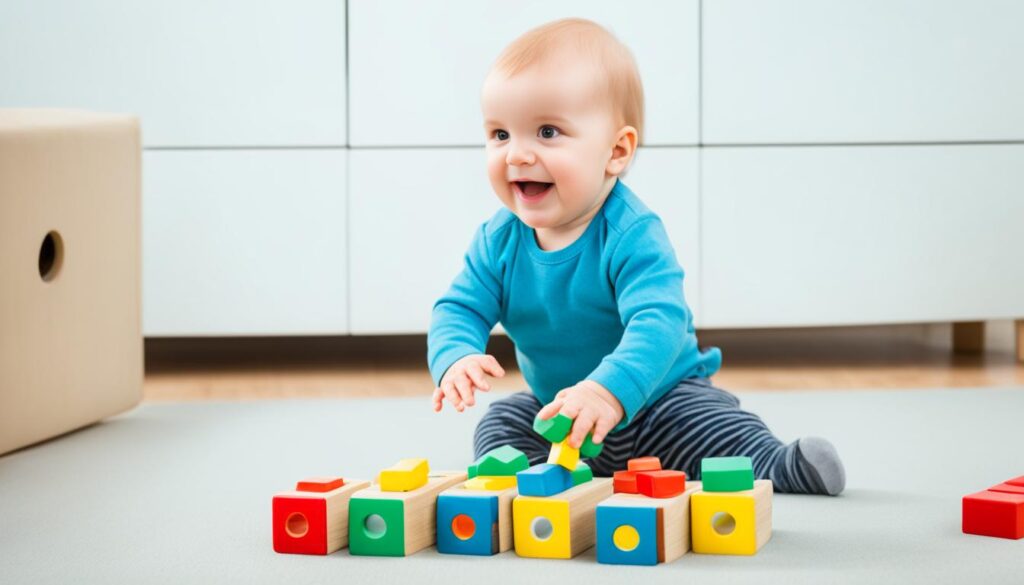

So, knowing and spotting developmental milestones is vital. It helps us keep an eye on a child’s progress. This way, we can catch any issues early and get the right help for the child’s growth.
The importance of developmental milestones in child psychology
Developmental milestones are key in child psychology. They are the basis for healthy growth in early years. Around 85% of a person’s brain is formed by age five. This makes the first five years very crucial6. Milestones show how a child grows physically and improves their thinking skills6.
It’s important to know and keep track of these stages. This way, we can spot any slow growth or problems early6. And when we catch them early, parents and teachers can help the child do better. Milestones give us clues about a child’s actions, thoughts, how they get along with others, and their feelings6.
In the first three months of life, babies learn to move and control their bodies6. Then, from 3 to 6 months, they start to roll over, sit with help, and use their hands better6.
At 6 to 9 months, babies begin to move more. They explore, pick up things, and can sit without help6. Between 9 to 12 months, many babies can sit by themselves, pull up to stand, and even take their first steps. They also get better at using their hands for small tasks6.
These skills keep growing as children get older. They start to draw, climb stairs, hop on one foot, and use scissors safely, which is good for their big and small muscle skills6.
Thinking abilities are also very important in child growth. From seeing faces and hearing sounds at first, toddlers learn to pretend, look at books, and enjoy playing by 1 to 2 years6. As they hit 2 to 3 years, they do more complex things like sorting toys, listening to simple commands, and enjoying pretend play. They also recognize themselves in the mirror, which shows more independence6.
From 3 to 4 years, children start to reason and sort things. They begin to understand time and they ask many questions. This shows they’re learning to think in more advanced ways6. By the time they’re 4 to 5, they get even better at talking, copying adults, counting, and other skills. All of this means their thinking is getting pretty sharp6.
Sometimes, children might not reach these milestones when they should. Knowing about these steps helps us find problems early. In the U.S., about 1 in 4 kids under 5 might have some kind of slow development7. Plus, 1 in 6 kids from 3 to 17 years might have a big challenge7. Sadly, not many kids with issues get help before they turn 3. And sometimes, we don’t even know there’s a problem until they start school. By then, we might have missed chances to help them early7.
Recognizing how important these milestones are can make a big difference. Parents, teachers, and others can use this info to support and guide children. Keeping an eye on milestones helps ensure kids grow up healthy and happy. It supports their thinking and how they feel about themselves67.
Developmental milestones by age
It’s important to know the key milestones as children grow. This helps ensure they are developing as expected. Below are some of these milestones for different ages.
Infancy (0-12 months)
In the first year, babies hit many key milestones. They start with a smile and can quickly move up to rolling over, sitting, crawling, and finally walking. Most start walking between 8 and 18 months, which is normal8.
Early Childhood (1-3 years)
Between ages one to three, children learn a lot. They start talking more, playing make-believe games, and doing things on their own. These steps prepare them for more learning and growth9.
Preschool Age (3-5 years)
Preschool is when kids focus on language and social skills. They get better at talking, enjoy more creative play, and understand basic ideas like colors and numbers. Keeping an eye on their development is crucial to make sure they’re keeping up10.
School Age (6-12 years)
This is when kids really start to develop their thinking and social skills. They get better at talking and learning, make friends, and start puberty. Girls might get their period as early as 6, and both boys and girls show signs of growing up between 12 and 18 years8.
Adolescence (13-18 years)
Teenage years are full of quick changes. They grow physically, figure out who they are, and deal with social life. Watching how they hit milestones at this stage can help catch and deal with issues early9.
Knowing the milestones for each age is key for parents, caregivers, and doctors. It allows them to help kids grow at their best. By keeping track of these stages, they can spot any delays and step in to help.
Monitoring child development with growth charts
Growth charts are very useful. They help to check a child’s height and weight. This is compared to other kids the same age and sex.
Because of this comparison, doctors can see any growth problems early. They can also check if the child’s health is good over time.
Many things affect how a child grows. These include genes, food, moving around, and how they feel. Growth charts keep these in mind. They let doctors understand how a kid is growing.
It’s vital to watch a child’s growth regularly. This helps to catch any issues fast.
The American Academy of Pediatrics suggests screenings at certain ages11. These are important to look for possible autism or other problems. Growth charts are key in this.
Doctors use growth charts to spot changes in growth. They also look at the child’s BMI. If the BMI is too high or low, this could signal health problems.
But remember, growth charts are used with many other checks. This gives a full picture of a child’s growth.
For parents, growth charts are not just for doctors. They can watch how their child is growing. This helps them see if their kid is doing like others their age.
The CDC’s Milestone Tracker app is a great tool11. It lets parents follow their child’s progress. It also gives tips on how kids should grow.
There are many resources for parents, and they come in different languages11. This is so all parents can find help and info about their child’s growth.
Childcare providers also use helpful checklists from the CDC12. This supports parents in watching their child’s development. Working together, doctors and childcare workers help kids develop well.
To sum up, growth charts are key in watching a child’s progress. Together with other tools, they give everyone involved a good view. This helps spot and deal with any issues early.
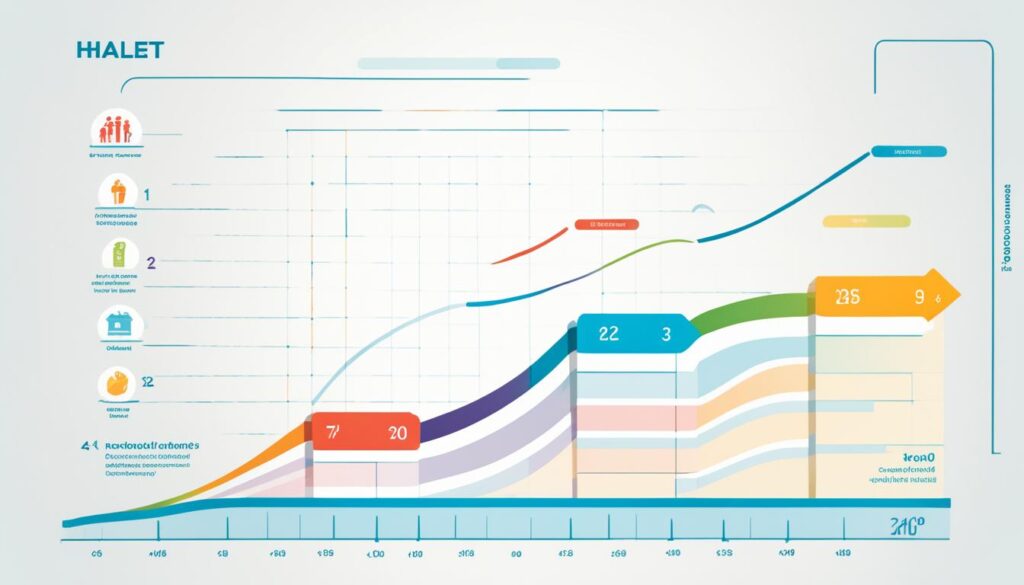

11 American Academy of Pediatrics. (n.d.). Developmental Surveillance and Screening of Infants and Young Children. Retrieved from [insert link]
12 Centers for Disease Control and Prevention. (n.d.). CDC’s “Learn the Signs. Act Early.” Program. Retrieved from [insert link]
Factors influencing child growth and development
Child growth and development are shaped by many things. These include genes, the environment, and how much money a family has. It’s key to know these to help children grow in a healthy way.
Genetics from parents impact how tall, smart, and talented a child is13. But remember, genes aren’t the only thing affecting growth and development.
The world around us, including where we live and who we know, also makes a big difference14. A child’s growth can be influenced by how healthy their living space is, if they see a doctor, and their friends. Even health issues and the hormones in their body play a part13.
Eating well is vital for kids’ growth and health. Getting the right food helps the body and mind to grow. This shows how important a healthy diet is for children.
Staying active and healthy is different for every child’s growth14. Playing sports, using educational toys, and doing art or meditation are great for them. These help with both physical and mental development.
How a family and community treats a child also matters a lot14. Love and support at home and at school are crucial. They build a child’s social and mental skills, along with what they learn in class.
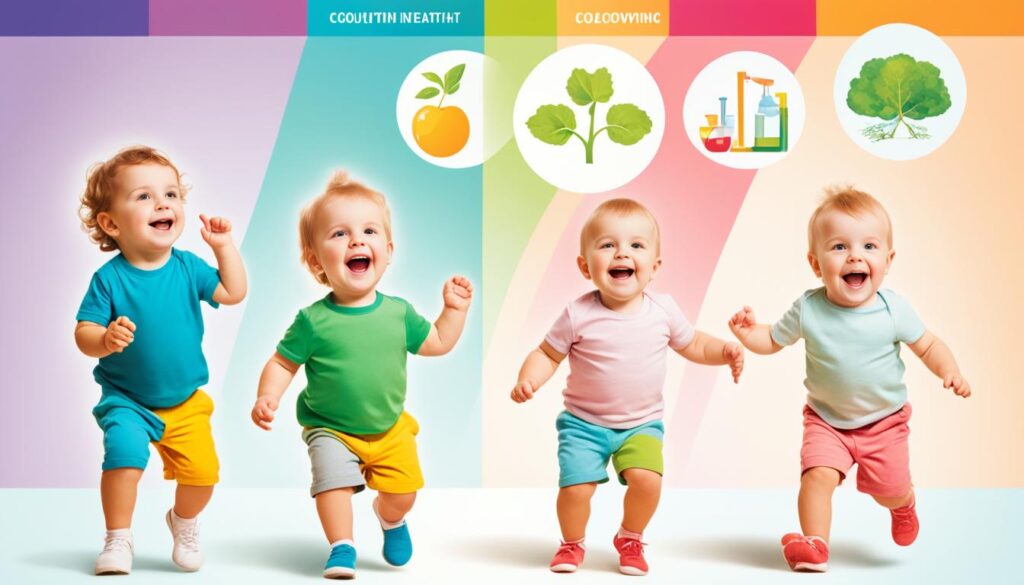

Where we live, the air we breathe, and the people around us all affect how we grow15. For instance, a 2022 study found that bad air can hurt a child’s learning15.
If a family has a lot of money or not can change a child’s life14. The area they live in and the schools there contribute to their growth13. It’s important to talk about how money affects what opportunities children have.
In summary, how a child grows is influenced by their genes, what they experience every day, and how much money their family has. Creating a loving, healthy environment with good food, activity, and care is best for their growth and development.
Child growth charts: Interpreting the data
Looking at child growth charts involves thinking about many things. It’s not just one number that tells us everything. Doctors look at a child’s health, their genes, and what is normal for kids their age. Changes in how a child grows can sometimes seem like a big deal, but they might not be. These shifts are a part of growing up and not always signs of trouble. Each child grows in their own way, and this is okay.
If you worry about your child’s growth, talking to a doctor is a good idea16.
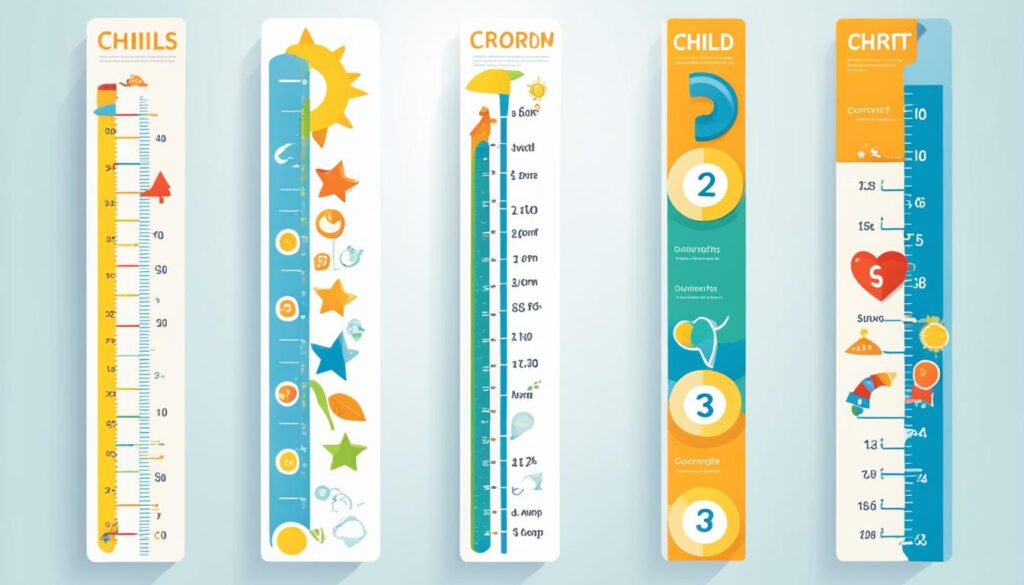

Child growth charts are key for checking on a child’s health and growth. Charts from the World Health Organization (WHO) and the CDC are common. Doctors use these to watch how kids grow and catch any problems early17.
The WHO tells us how to spot abnormal growth. Their guidelines help doctors find kids who might need more care. For example, if a child is way smaller or larger than most, this could be a sign. These rules make it easier for doctors to know when to act16.
CDC growth charts cover the 1970s, 80s, and 90s and are good for kids up to 19 in the U.S. Doctors use these to look for health and nutrition worries. The BMI is a tool they use. It shows if a child is a healthy weight or not. The charts have clear marks for when a child’s weight is too high, too low, or just right17.
It’s crucial to remember each child is different16. When a child turns 2, growth chart readings might change. This change shouldn’t always cause worry. But, keeping an eye on health and nutrition is crucial if growth markers look off17.
Importance of early intervention for child development
Early intervention is key in helping children grow healthy, supporting their journey with needed help and resources18. It catches and tackles delays or issues from the get-go, ensuring better results later on. These positive gains are seen in how well they talk, make friends, and think18.
It targets kids from birth to 3, offering help like speech and physical therapy as needed18. If a child qualifies for these services due to delays, they often get them for free or at a low cost. This shows that getting help early is easy and affordable18.
Jumping in early really works, helping children learn, act better, and stay healthier later18. The brain grows the most in the first three years, making it crucial time for helping these connections. With the right support, children can reach their full potential18.
Research proves starting early can change children’s lives for the better, even through teens19. It tackles a wide range of areas like how they move, think, learn, and feel, making a big difference. The aim is to lower risks and boost positives, improving many skills along the way19.
Helping children control themselves better early on boosts how they do in friendship and at school19. It aims to cut down on bad actions and steer away from crime later. Targeting how they connect with others and feel about themselves, it also fights off mental health issues19.
Early care and support also fights off big threats to kids, like abuse or substance abuse19. It plays a big part in protecting them and promoting healthy choices. This all adds up to making a big difference in a child’s life19.
The field has broadened its view to see how bigger matters affect children, like family income or violence20. For over 40 years, the U.S. has worked on many programs to help kids do better before kindergarten20. Early care now covers a wide area, from health tips to helping families in need, showcasing a big effort to ensure all kids grow up well
.
Early help is offered in different ways, like going to a center or getting visits at home, from experts in many fields20. These teams work closely together, using plans that connect their goals to what they do. Now, their work also focuses on how homes, jobs, and communities play a part in healthy child growth20.
Parents get a big boost from early help, empowering them to aid their children’s early needs for long-lasting benefits18. Even when there’s a wait for specialized services, simple things like reading and playing help a lot. Apps like the CDC’s Milestone Tracker also make watching your child’s growth and sharing concerns with experts easier18.
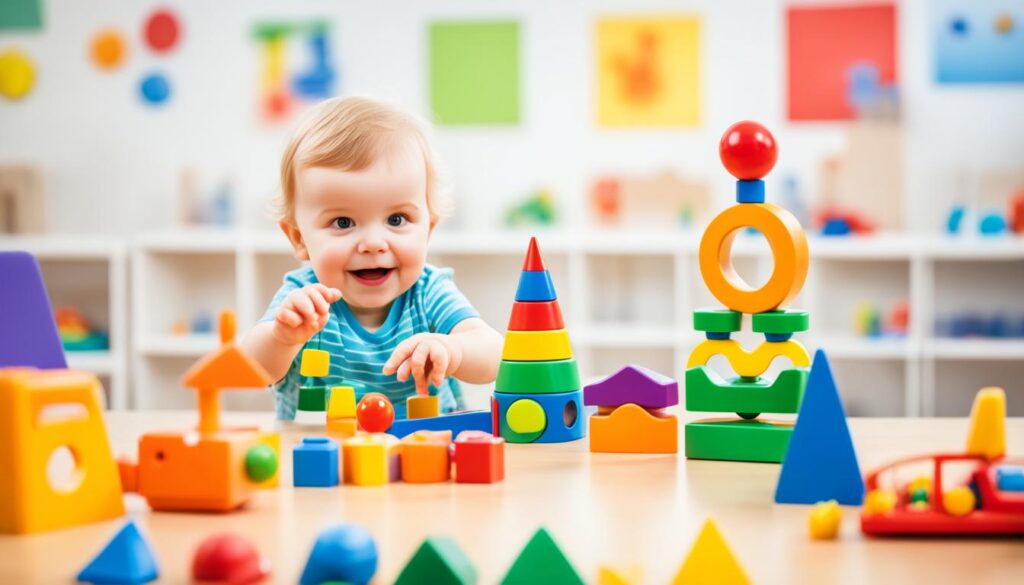

Supportive parenting for optimal child development
Supportive parenting is key for a child’s best growth. Nurturing and stimulating home environments support this development. It includes offering love, being responsive, and creating a strong bond with your child.
Positive parenting advocates building strong bonds with kids21. They want every child to live a meaningful life21. This method uses sensitivity, warmth, and considering a child’s feelings for better brain growth21.
Building cognitive skills early helps in education and future success21. Studies show positive parenting boosts mental and language skills in kids up to six years old21. This not just makes the home a happier place but also lifts their cognitive and reading abilities21.
Not all parenting styles help kids in the same way. There are different types which affect child growth differently. For example, an authoritarian style may lead to obedient kids, but they could lack confidence22. Permissive parents tend to be very loving but might not teach kids self-discipline22. Disengaged parents can leave children feeling lonely, anxious, and at risk of bad habits22.
Supportive parenting is seen as the best approach. It combines warmth, guidance, and good discipline skills22. This method results in kids who feel sure of themselves, are mature, and enjoy being happy22. This style also helps children socially and in their relationships with others23.
Parents should always look to improve their parenting skills. They can turn to health experts for advice and find helpful programs23. By doing this, parents can create a space where their child thrives, both intellectually and socially. A good start like this paves the way for a bright future.
Individuality in child development
It’s vital to see and support the unique ways each child grows in child psychology. Each kid has their own timing and speed of development24. Things like genes, personality, and experiences make each child’s path different24. Don’t compare kids since their growth is influenced by what makes them special24. Instead, focus on knowing and helping each child’s personal skills and needs24.
By accepting and cherishing what makes each child different, we pave the way for them to excel. Research shows babies start picking up patterns in speech sounds to learn language25. Infants and toddlers also start forming ideas about why things happen the way they do25. This helps them grasp how the world works, both with objects and people25. They learn a lot by watching others and quickly learn who they can trust for info25.
Scientists use smart tests, like watching how long a baby looks or their expressions, to learn about kid’s thoughts25. Babies start connecting what they see into logical ideas, organizing their thoughts25. By just one year old, they’re already building basic theories about the world around them. These ideas are crucial for their future learning and understanding25.
Conclusion
It is crucial to understand how children grow and learn. This knowledge helps in child psychology and parenting. We should watch for key steps in their development and support them. In the Preoperational stage (ages 2 to 7 years), kids grow a lot and start doing things like adults26. They also start to think in symbols, play make-believe, and talk a lot more26. At this time, they begin to show more emotions and care about others26.
Kids make friends and get closer to their families in the Preoperational stage26. They start to understand right from wrong and explore their gender differences26. In recent years, we’ve learned a lot about kids’ brains and behaviors. We found out that early development is very strong but also easily influenced27.
From birth to age 5, kids learn and grow extremely quickly, setting the stage for their future27. But, many families face financial challenges, and health outcomes can vary based on race and ethnicity27. Making sure kids have good early experiences is key for their entire life27. Studies are looking into how to check the quality of care kids get. They focus on things like preventing diseases and health care for all28.
Knowing about child psychology and development helps us help kids early. This is crucial to avoid problems and ensure they do well. Each child is different and needs special attention. By focusing on children’s needs and how they grow, we can make a big difference in their lives.
FAQ
What are developmental milestones?
Developmental milestones are skills children usually have at certain ages. They cover many areas like talking, dressing, and using hands and eyes. Also, they include learning how to care for oneself.
Why is it important to recognize and understand developmental milestones?
Knowing these milestones helps check if a child is growing well. They give clues about a child’s health and find possible problems early.
How can I recognize developmental milestones in children?
Parents and teachers can watch how children play, learn, talk, and interact. They can compare a child’s progress with others. Using checklists can help, but talking to a pediatrician is vital for a good check.
What role do developmental milestones play in child psychology?
Milestones show a child’s learning and growth. Not reaching them on time might mean a child needs help. Knowing and tracking these steps can show us how a child is developing mentally, socially, and emotionally.
What are some examples of developmental milestones for different age ranges?
Milestones change with age. They include first steps, first smile, waving bye, and first words. These are common signs children are growing and learning.
How do growth charts help monitor a child’s development?
Growth charts compare a child’s size with others the same age. They spot if a child is not growing as expected. But, they are just one part of checking a child’s health and development.
What factors influence child growth and development?
Many things can affect how a child grows and learns. This includes genes, what a child eats, how much they move, their general health, where they live, and if they have had any health issues.
How do I interpret child growth charts?
Understanding growth charts means looking at many things. This includes the child’s health, family background, and how they meet their growth and learning goals. Doctors can give the best help here.
Why is early intervention important for child development?
Getting help early can really change the path for a child. It can help in finding and fixing problems that might slow down or block the child’s learning and growth. This support aims to help every child do their best.
How can supportive parenting promote optimal child development?
Good parenting means offering a warm, safe, and interesting world for the child. It also means being there for the child, talking and playing with them, helping them feel secure, and supporting their curiosity. Using all available help and support is important.
Why is individuality important in child development?
Each child grows and learns in their way. Recognizing and supporting what makes a child special helps them do well. It helps create a welcoming space for the child to grow and learn confidently.
How can I ensure that my child receives the necessary support for their development?
Knowing about child development, noticing key steps, checking growth charts, and supportive parenting are big steps. Early action and talking often with health experts are also crucial.
Source Links
- Piaget Cognitive Stages of Development – https://www.webmd.com/children/piaget-stages-of-development
- What Is Piaget’s Theory of Cognitive Development? – https://www.verywellmind.com/piagets-stages-of-cognitive-development-2795457
- Understanding Child Development: Milestones, Stages, and Growth – LCH Health & Community Services – https://lchcommunityhealth.org/understanding-child-development-milestones-stages-and-growth/
- Early Childhood Development Milestones – https://www.gcu.edu/blog/teaching-school-administration/early-childhood-development-milestones
- Training Module 2 | Watch Me! | Learn the Signs. Act Early. | NCBDDD – https://www.cdc.gov/ncbddd/watchmetraining/module2.html
- Important Child Development Stages – First 5 Years | Children’s Bureau – https://www.all4kids.org/news/blog/why-the-first-5-years-of-child-development-are-so-important/
- Developmental Milestones Matter – CWLA – https://www.cwla.org/developmental-milestones-matter/
- Developmental milestones record: MedlinePlus Medical Encyclopedia – https://medlineplus.gov/ency/article/002002.htm
- Child Development: Milestones, Ages and Stages – Children’s Hospital of Orange County – https://choc.org/primary-care/ages-stages/
- Development Milestones – StatPearls – NCBI Bookshelf – https://www.ncbi.nlm.nih.gov/books/NBK557518/
- Training Module 3 | Watch Me! | Learn the Signs. Act Early. | NCBDDD – https://www.cdc.gov/ncbddd/watchmetraining/module3.html
- PDF – https://www.cdc.gov/ncbddd/watchmetraining/docs/watch-me-training-print.pdf
- Factors Affecting Child Growth and Development – https://parenting.firstcry.com/articles/factors-that-affect-growth-and-development-in-children/
- Factors That Affect Growth And Development in kids – Smartivity – https://www.smartivity.in/blogs/future-makers/10-factors-that-affect-growth-and-development-in-children
- Factors that influence growth and development – https://online.marquette.edu/education/blog/factors-that-influence-growth-and-development
- Assessing Growth | Using the WHO Growth Charts | Growth Birth to 2 Years | WHO | Growth Chart Training | Nutrition | DNPAO – https://www.cdc.gov/nccdphp/dnpao/growthcharts/who/using/assessing_growth.htm
- Use and Interpretation of the WHO and CDC Growth Charts for Children from Birth to 20 Years in the United States. – https://www.cdc.gov/nccdphp/dnpao/growthcharts/resources/growthchart-508.pdf
- Learn the Signs. Act Early – https://www.cdc.gov/ncbddd/actearly/whyActEarly.html
- What is early intervention? – https://www.eif.org.uk/why-it-matters/what-is-early-intervention
- Promoting Healthy Development Through Intervention – From Neurons to Neighborhoods – https://www.ncbi.nlm.nih.gov/books/NBK225561/
- Positive Parenting and Children’s Cognitive Development – https://www.psychologytoday.com/us/blog/going-beyond-intelligence/202302/positive-parenting-and-childrens-cognitive-development
- Parenting SA – What parenting style works best for children? – https://parenting.sa.gov.au/easy-guides/what-parenting-style-works-best-for-children-jodie-benveniste
- Parenting and Child Development: A Relational Health Perspective – https://www.ncbi.nlm.nih.gov/pmc/articles/PMC7781063/
- Behavior Due to Individual Differences – AbilityPath – https://abilitypath.org/ap-resources/behavior-due-to-individual-differences/
- Child Development and Early Learning – Transforming the Workforce for Children Birth Through Age 8 – https://www.ncbi.nlm.nih.gov/books/NBK310550/
- Early Childhood Conclusion – https://www.mentalhelp.net/conclusion/
- Conclusions and Recommendations – From Neurons to Neighborhoods – https://www.ncbi.nlm.nih.gov/books/NBK225551/
- 6 Conclusions and Recommendations | Child and Adolescent Health and Health Care Quality: Measuring What Matters – https://nap.nationalacademies.org/read/13084/chapter/8
